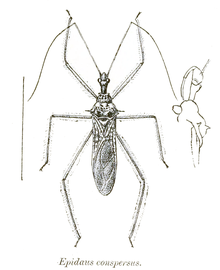Epidaus
Epidaus is a genus of assassin bugs with about 25 species mainly distributed mainly in the Oriental Realm with two species (E. nebulo and E. tuberosus) which extend into the Palearctic Realm. Most species have a long and narrow body with the pronotum having a posterior margin with raised corners and spiny outgrowths facing outwards. The head a tubercle behind the base of each of the two antennae.[1][2]
| Epidaus | |
|---|---|
 | |
| Epidaus conspersus | |
| Scientific classification | |
| Kingdom: | Animalia |
| Phylum: | Arthropoda |
| Class: | Insecta |
| Order: | Hemiptera |
| Family: | Reduviidae |
| Tribe: | Harpactorini |
| Genus: | Epidaus Stål, 1859 |
| Type species | |
| Zelus transversus Burmeister, 1835 | |
Species included in the genus include:
- Epidaus alternus Bergroth, 1915
- Epidaus atrispinus Distant, 1904
- Epidaus bachmaensis Truong, Zhao and Cai, 2006
- Epidaus bicolor Distant, 1903
- Epidaus compressispinus Breddin, 1900
- Epidaus connectens Distant, 1919
- Epidaus conspersus Stål, 1863
- Epidaus famulus (Stål, 1863)
- Epidaus furculatus Stål, 1863
- Epidaus incomptus Miller, 1941
- Epidaus insularis Zhang, Zhao, Cao and Cai, 2010
- Epidaus kedahensis Miller, 1941
- Epidaus latispinus Stål, 1863
- Epidaus longispinus Hsiao, 1979
- Epidaus maculiger Stål, 1859
- Epidaus nebulo (Stål, 1863)
- Epidaus pantolabus Miller, 1941
- Epidaus parvus Distant, 1904
- Epidaus pellax Miller, 1941
- Epidaus pretiosus Distant, 1903
- Epidaus sexspinus Hsiao, 1979
- Epidaus transversus (Burmeister, 1835)
- Epidaus tuberosus Yang, 1940
- Epidaus validispinus Stål, 1863
- Epidaus wangi Chen, Zhu, Wang and Cai, 2016
References
- Zhang, Guanyang; Weirauch, Christiane (2014). "Molecular phylogeny of Harpactorini (Insecta: Reduviidae): Correlation of novel predation strategy with accelerated evolution of predatory leg morphology". Cladistics. 30 (4): 339–351. doi:10.1111/cla.12049.
- Zhang, Wenjie; Zhao, Ping; Cao, Liangming; Cai, Wanzhi (2010). "Description of a new species of genus Epidaus Stål (Hemiptera: Reduviidae: Harpactorinae) from China, with a key to Chinese species". Zootaxa. 2517: 62. doi:10.11646/zootaxa.2517.1.7.
This article is issued from Wikipedia. The text is licensed under Creative Commons - Attribution - Sharealike. Additional terms may apply for the media files.